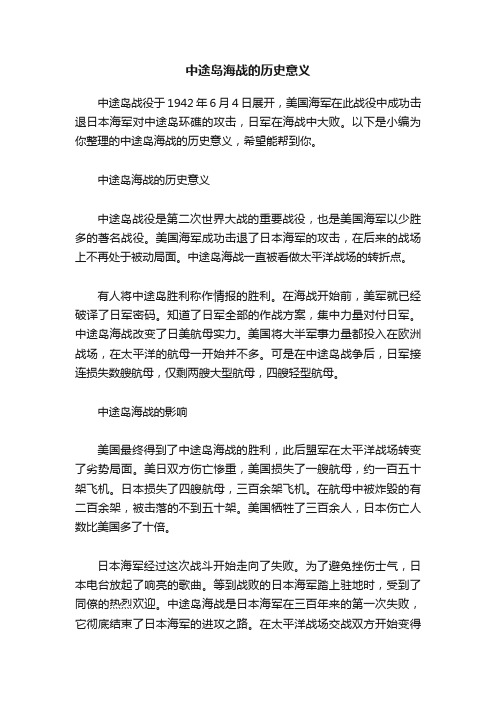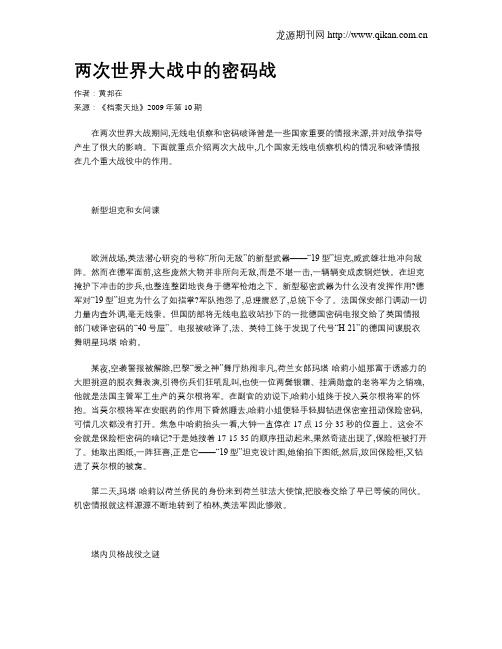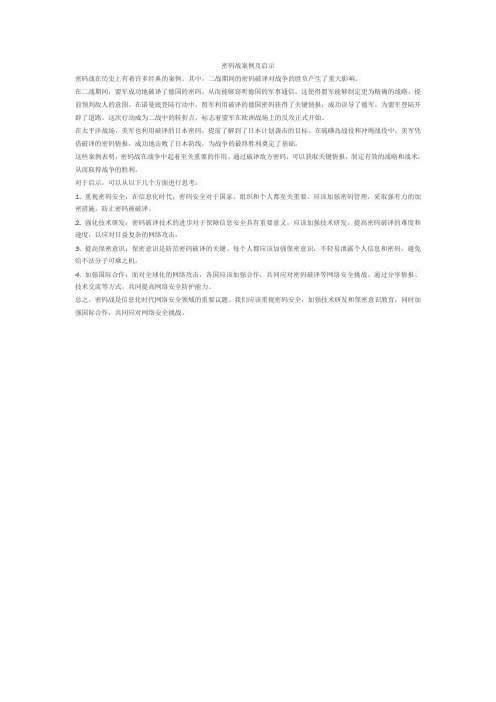中途岛战役中的密码故事
为了密码,他与潜艇沉入海底

” 通信使用的 “ N 5 J 2 ”密码。“ N 2 密码 门,协助他们分析密码。 J一5
在大量的信息帮助下,破译专家逐渐理出了
“ 称为当时 “ 最安全、 最不可能被破译”的密码。 头绪,他们向上司报告说 : 我们虽然还不能完 全破解,但已经能解出其中一部分的内容了, 再 殊不知,美固在日本偷袭珍珠港之前。就 已有 j ” 专家开始研究 “ N 2 ”密码了。不过那时日 加上一些猜测,厦不难掌握日本海军的动向了。 J一5 本海军活动不多,通信量也不大 .美国破泽人 当然.所有知情的美国人鄯d 心翼翼地保 、 护着这个秘密。 可不 能让日本人知道咱们 已 经破译了他们的部分密码,他们一旦知道了, 就会更换密码 ,那样 咱们破泽的 ‘N 2 ’ J ,一5着浮出水面,想重 为了守住秘密保证战争的胜利.他毅然决然地 大头鱼”号一同沉人海底。 新去追逐击沉日本运输船 但这次日本人早有 选择了与 “ 防备.特别留下一艘驱逐舰断后。“ 大头鱼”号 克伦 威尔用 生命 护卫 了关于 密码的 秘 刚一从海里露头就被发现,两者相距仅 5 0 密,成为 美国海 军潜艇 部队中获得荣誉勋章 5 米。 4年 .为 了纪 念 克 伦 威 尔 9 日本驱逐舰马上发射第一轮深水炸弹 ,大 的最 高 级 军 官 。 1 5 “ 头鱼”号冒着密集的弹雨再次紧急下潜。没等 的壮举 .美 国海 军将 一艘护卫驱逐舰 命名为 它下潜到安全深度,日寇又发射出第二轮深水 炸弹,炸弹炸毁了潜艇的深度计。不过艇长并 没有发觉。此时,海上恰巧 一阵风雨袭采.日 本驱逐舰暂时停止了对潜艇的追逐攻击。
炸弹。“ 大头鱼” 号多处受损, 踉跄着潜人水下 ,
员没有掌握足蟹的信息量进行破译。
疆■ ‘ 头 ■。■ 丈
1 4 年秋.美国海军准备夺取吉尔伯特 3 9 群岛。战争发起前。美海军事先把十多艘潜艇 埋伏在群岛以西、以北的图尔克岛和卡瓦加雷 岛附近,以监视岛上的日军基地动向。
中途岛海战的历史意义

中途岛海战的历史意义中途岛战役于1942年6月4日展开,美国海军在此战役中成功击退日本海军对中途岛环礁的攻击,日军在海战中大败。
以下是小编为你整理的中途岛海战的历史意义,希望能帮到你。
中途岛海战的历史意义中途岛战役是第二次世界大战的重要战役,也是美国海军以少胜多的著名战役。
美国海军成功击退了日本海军的攻击,在后来的战场上不再处于被动局面。
中途岛海战一直被看做太平洋战场的转折点。
有人将中途岛胜利称作情报的胜利。
在海战开始前,美军就已经破译了日军密码。
知道了日军全部的作战方案,集中力量对付日军。
中途岛海战改变了日美航母实力。
美国将大半军事力量都投入在欧洲战场,在太平洋的航母一开始并不多。
可是在中途岛战争后,日军接连损失数艘航母,仅剩两艘大型航母,四艘轻型航母。
中途岛海战的影响美国最终得到了中途岛海战的胜利,此后盟军在太平洋战场转变了劣势局面。
美日双方伤亡惨重,美国损失了一艘航母,约一百五十架飞机。
日本损失了四艘航母,三百余架飞机。
在航母中被炸毁的有二百余架,被击落的不到五十架。
美国牺牲了三百余人,日本伤亡人数比美国多了十倍。
日本海军经过这次战斗开始走向了失败。
为了避免挫伤士气,日本电台放起了响亮的歌曲。
等到战败的日本海军踏上驻地时,受到了同僚的热烈欢迎。
中途岛海战是日本海军在三百年来的第一次失败,它彻底结束了日本海军的进攻之路。
在太平洋战场交战双方开始变得势均力敌。
中途岛战役也在日本军官的心中留下了难以磨灭的痕迹,他们无法相信失败。
这次的痛苦失败让他们在以后的战争中再也不能做出清醒的判断。
还原历史真相 美日中途岛战役和击毙山本五十六战斗中的密码情报战

还原历史真相美日中途岛战役和击毙山本五十六战斗中的密
码情报战
吴明冰
【期刊名称】《舰船知识》
【年(卷),期】2009(000)010
【摘要】近来随着一些涉及密码情报战的影视作品热播,一些文学作品、新闻媒体也刊登了相关报道。
其中有些报道说“传奇人物之某某某‘破译日军密电助美击毙山本五十六’”。
许多读者来信中,特别关注到底是谁破译了珍珠港、中途岛和击毙山本五十六的情报?
【总页数】2页(P76-77)
【作者】吴明冰
【作者单位】无
【正文语种】中文
【中图分类】TN918.2
【相关文献】
1.浅析中途岛海战中的美日情报战
2.制胜的关键 --从中途岛战役看情报在决策中的威力
3.何以还原历史真相——晋绥边区黄树坪战斗之考察
4.银翼对抗,棋在局外中途岛战役的美日战机
5.从中途岛战役看美日情报工作
因版权原因,仅展示原文概要,查看原文内容请购买。
逆转战局的密码战——浅析中途岛海战中的情报问题

逆转战局的密码战——浅析中途岛海战中的情报问题何理军事密码是战争中使用的保密工具,用于传递消息。
破译军事密码往往在战争中能起到四两拨千斤的效果,因此密码战成为了军事战争中的又一大战略阵地。
在二战太平洋战争中,这样的作用尤其明显。
不论是珍珠岛海战还是瓜岛战役,常常逆转战局的密码战产生了深远持久的影响。
从破译奇才池步洲到情报专家莱顿中校,这些让军方“耳聪目明”的情报工作者发挥了摧枯拉朽的作用。
本文试论密码战在太平洋战争中不可磨灭的价值。
关于情报学和密码学的历史研究不算少见,而研究第二次世界大战或太平洋战争的同样不少,尤其是关于中途岛海战中的情报问题。
在这个领域,不可置疑的共识是密码战对二战影响巨大,诚如丘吉尔所说“密码破译者是战争中下金蛋最多的鹅”。
本文在此基础上,分析了密码战的破译的战略性意义,并对未来战争中的情报问题进行展望。
一、密码战的历史回眸密码在古代曾被称为 “阴符”、 “阴书”,用于信息保密工作。
战争密码自古有之,而且密码最重要的应用也是军事,军事密码常常成为军队作为保密联络和发送指令的渠道。
《高卢战记》中记载过一个这样的小故事,古罗马的军队统帅凯撒发明了一种把字母表中所有字母按照一定顺序循环移位的加密方法。
例如,移位数为3时,A就变成了D,B成了E,C成了F……以此类推,单词“hello”就成了“khoor”,必须逆移三位字母才能解码。
相传,凯撒就是这样和他的将士传递情报的。
随着现代信息技术的发展,密码学也赢来了其辉煌时期,产生了序列密码、分组密码、公钥密码等多种分类。
战争中交战双方常常通过破译密码来获取对方的战争情报,这样“知己知彼”的信息情况会造成信息不对称的结果,而掌握密码的一方就能获得战争的主动权。
在第一次世界大战中,英国成功破解了德国的“齐默尔曼电报”,使得美国放弃中立地位而对德宣战,改变战争走向。
二战初期,因为无线电密码被德国人破译,而使北非战场英军详细作战计划被源源不断送到德军将领隆美尔的案头,使英军陷于被动境地,直至更换密码,才使德军不再“耳聪目明”。
抗日战争历史故事-抗战时破译了日军密码的奇才

抗⽇战争历史故事-抗战时破译了⽇军密码的奇才系列抗战剧上演,其中有⼀个⾮常令⼈兴奋的亮点,那就是在关键时刻破译⽇军的密码,从⽽使我军转败为胜。
回读辉煌的抗战史册,你会发现这绝⾮虚构。
其实,这⼀细节的背后,确实有相当⼀⼤批奇才⽤这种⼿段屡⽴战功。
其中不乏外国⼈,也有⼋路军⽅⾯和国军⽅⾯的。
下⾯⼩编给⼤家讲⼀讲抗⽇战争历史故事-抗战时破译了⽇军密码的奇才。
抗战时破译了⽇军密码的奇才林迈可林迈可出⽣于英国的⼀个世代书⾹门第。
1937年他受北平燕京⼤学聘请,担任燕⼤的经济学导师,并领导创办⽜津⼤学式的导师制。
1941年12⽉7⽇,⽇本偷袭珍珠港,揭开了太平洋战争的序幕。
林迈可带着妻⼦和班威廉夫妇驾驶校长的汽车,逃出北平。
经地下⼯作者和游击队的护送,到达晋察冀平西根据地。
在平西,受聂荣臻将军的邀请,林迈可担任通讯部技术顾问。
他给部队技术员讲授⽆线电⼯课程,由于没有教材,很多课程内容不得不从最基本的电学第⼀定律开始。
林迈可的妻⼦李效黎也在通讯部⼯作,任英语课教员。
他们发现,⽤中⽂发报会有许多的⿇烦,⼀个数码错了,就会译成完全不同的另⼀个字,英语是以字母形式构成的语⾔,拼错⼀个字并不会影响理解原意。
于是,他们共同帮助部队⽤简单的英语来传递信息。
从1942年到1944年,林迈可⼀直在晋察冀军区,从事电台设备的整修改进和教学⼯作。
在晋察冀的学⽣中有很多⼈后来成为新中国电讯界的⾼级⼲部、技术专家和⾻⼲。
在延安,林迈可⼀⽅⾯为延安的通讯和新闻事业尽⼒。
另⼀⽅⾯,他还主动撰写稿件报告边区概况,请经过和离开延安的外国⼈带⾛,或发送给合适的报社、政府机关,或任何对抗⽇根据地感兴趣的⼈。
林迈可在中国战⽃和⽣活了8年,他的⼀⼉⼀⼥都出⽣在抗⽇根据地。
他⽤刚到北平时购买的⼀架德国造的蔡斯伊康照相机,把⾃⼰和平西、晋察冀、延安军民的抗战⽣活拍摄下来,从战争年代⼀直保存⾄今。
亚德雷1938年11⽉,化名为“罗伯特·奥斯本”的“美国密码之⽗”亚德雷经⾹港抵达中国战时陪都重庆。
二战中的经典计谋

1.阿拉曼战役中英军元帅蒙哥马利在北非为了击败沙漠之狐隆美尔的装甲部队时专门请来了伦敦的电影导演用一些伪装手法帮忙“隐藏“自己的装甲部队,狩猎行动成功,北非战场转折点。
2.太平洋战区中途岛战役中。
美国海军司令尼米兹截获的日本一个情报暗号”AF“(应该是,记得不清楚),当时他们不肯定是不是指的就是中途岛,参谋建议在中途岛的电报中用明码说岛上基地的淡水设施坏了。
后来再截获的日本情报中日军提及到了这一点,美军因此确认了日军的下一目标。
战役中,关键性的五分钟,日军在航行期间卸下了鱼雷等各种武器,突然美军的出现令日本措手不及。
战役中日军四艘航母沉了。
3.诺曼底登陆的准备中,为了掩饰,英军找了一个很像蒙哥马利的中尉,培训他,学习蒙哥马利的各种行为动作,派他到了北非,让德军以为会在地中海地区登陆,真正的蒙哥马利却在英伦三岛准备着。
(PS:真的蒙哥马利滴酒不沾,假的那个却是个酒徒,去非洲的飞机上他偷酒喝,情报人员只能把他对着冷空气口才能快点消除酒气,面色不再红,下机后果然有德国间谍,还好,就这样中计了)诺曼底登陆前的情报和保密战最可圈可点。
盟军做到的最大的成就不是隐藏部队集结,而是隐藏了真实的攻击意图,让德军统帅部始终错误地认为盟军的攻击方向是加莱。
为了掩护真实的攻击方向,盟军的准备包括了一系列欺骗和掩护行动。
包括:∙坚毅行动,成立一组实际上不存在的军团迷惑敌军。
坚毅行动中最为人所知的大约是由巴顿将军挂帅,假装进攻加莱的“美国第一集团军”,但事实上坚毅行动的子计划包括多个冒牌军团,伪装的进攻方向涵盖了挪威(镍矿基地)、比斯开湾(候补登陆点,威胁西班牙)、希腊克里特岛(通过地中海直指中欧),甚至罗马尼亚的黑海地区(德国本土外最重要的油田基地)。
坚毅行动的结果是将德军的多支精锐被分散到了各地,无法在诺曼底进攻开始时集结增援。
∙卫士行动,依靠伪造无线电通信和虚假目标欺骗德军侦查机,构造盟军集结地点在多佛尔和剑桥的假象。
军事中的密码

军事中的密码密码学是研究编制密码和破译密码的技术科学。
研究密码变化的客观规律,应用于编制密码以保守通信秘密的,称为编码学;应用于破译密码以获取通信情报的,称为破译学,总称密码学在公元前400年,密码起源于一根叫scytale的棍子。
送信人先绕棍子卷一张纸条,然后把要写的信息打纵写在上面,接着打开纸给收信人。
如果不知道棍子的宽度是不可能解密里面的内容的。
这就是最原始的密码。
在这里,棍子的宽度就相当于解密的密匙,要解密也不一定需要拿只棍子,只用知道真正的信息隔了多少距离出现即可。
例如,一张纸条上面写着“KGDEINPKLRIJLFGOKLMNI——SOJNTVWG”,每四位取一个字母,其他字母都是干扰,即可得密文“KILLKING”。
随着人类社会的发展,战争的不断发生,这种研究如何“能在敌人存在的环境下通讯”的科学逐渐发扬光大。
我本人对军事比较感兴趣,下面就讲两个军事上有关密码的有趣的故事。
在第一次世界大战中,1914年8月25日德国的马格德堡巡洋舰在芬兰湾搁浅,俄国搜出多份德国的文件及两本电码本,一本被送往英国的“40号房间”(Room 40)进行密码分析。
同时,无线电的发明亦使得截获密信易如反掌。
由于德国通往美国的电缆在大战开始时被剪断了,德国借用了美国的海底电缆发电报到华盛顿,但电缆经过了英国,1917年1月17日齐默尔曼电报被“40号房间”截获。
同年2月23日,密电内容揭开了,内容指德国将在1917年2月1日开始‘无限制潜艇战’,用潜艇攻击战时包括中立国在内的海上商运船。
为了阻止美国因此参战,德国建议墨西哥入侵美国,并承诺帮助墨西哥从美国手中夺回得克萨斯、新墨西哥和亚利桑那三州。
德国还要墨西哥说服日本共同进攻美国,德国将提供军事和资金援助。
密电内容揭开后,美国在4月16日向德国宣战。
在第二次世界大战中,德国汲取了第一次大战的教训,发展出以机械代替人手的加密方法。
雪毕伍斯发明了“谜”(ENIGMA,恩尼格玛密码机),用于军事和商业上。
两次世界大战中的密码战

两次世界大战中的密码战作者:黄邦在来源:《档案天地》2009年第10期在两次世界大战期间,无线电侦察和密码破译曾是一些国家重要的情报来源,并对战争指导产生了很大的影响。
下面就重点介绍两次大战中,几个国家无线电侦察机构的情况和破译情报在几个重大战役中的作用。
新型坦克和女间谍欧洲战场,英法潜心研究的号称“所向无敌”的新型武器——“19型”坦克,威武雄壮地冲向敌阵。
然而在德军面前,这些庞然大物并非所向无敌,而是不堪一击,一辆辆变成废钢烂铁。
在坦克掩护下冲击的步兵,也整连整团地丧身于德军枪炮之下。
新型秘密武器为什么没有发挥作用?德军对“19型”坦克为什么了如指掌?军队抱怨了,总理震怒了,总统下令了。
法国保安部门调动一切力量内查外调,毫无线索。
但国防部将无线电监收站抄下的一批德国密码电报交给了英国情报部门破译密码的“40号屋”。
电报被破译了,法、英特工终于发现了代号“H-21”的德国间谍脱衣舞明星玛塔·哈莉。
某夜,空袭警报被解除,巴黎“爱之神”舞厅热闹非凡,荷兰女郎玛塔·哈莉小姐那富于诱惑力的大胆挑逗的脱衣舞表演,引得伤兵们狂吼乱叫,也使一位两鬓银霜、挂满勋章的老将军为之销魂,他就是法国主管军工生产的莫尔根将军。
在副官的劝说下,哈莉小姐终于投入莫尔根将军的怀抱。
当莫尔根将军在安眠药的作用下昏然睡去,哈莉小姐便轻手轻脚钻进保密室扭动保险密码,可惜几次都没有打开。
焦急中哈莉抬头一看,大钟一直停在17点15分35秒的位置上。
这会不会就是保险柜密码的暗记?于是她按着17-15-35的顺序扭动起来,果然奇迹出现了,保险柜被打开了。
她取出图纸,一阵狂喜,正是它——“19型”坦克设计图,她偷拍下图纸,然后,放回保险柜,又钻进了莫尔根的被窝。
第二天,玛塔·哈莉以荷兰侨民的身份来到荷兰驻法大使馆,把胶卷交给了早已等候的同伙。
机密情报就这样源源不断地转到了柏林,英法军因此惨败。
塔内贝格战役之谜1914年10月,进攻沙俄的德国A-3集团军5万败兵,在新任司令官和参谋长兴登堡、鲁登道夫的带领下,仓促后撤,逃入德国境内,俄军竟未追击。
两次世界大战中的密码战

恩 尼格 马 密码 机 是 1 2 年 由 93
德 国工程师 阿图尔 ・ 泽尔 比乌斯研
“ 无耻 !” 尔逊总 统震怒 了 。 制 出来的 , 来又经 改进 。这种 密 威 后
“ 向德 国宣战 , 出兵墨 西哥 !” 码每 天换 一次密钥 。 德国人对这种 国家 安 全事 务 部 部长 和 参谋 长 联 密码 的秘密度一 直抱有信心
到 塔 内 贝 格 诸 高 地 南 侧 公 路 两 1 3 目 ” 月 1 旁 .从 三个 方面 合 成 一个 巨型 口 袋, 等待 敌 军 闯入 , 举全 歼 。切 一
波 、 、 三 国 合作 破 译 德 国 法 英
以2 万兵 力于 明 日下 午 5 前 占领 备 .务 必于3 时 月中 旬对 美 宣 战 。 不 恩 尼 格 马 密 码
了 。法 、英特 工 终 于发 现 了代 号 然 后 。 回保 险 柜 。 放 又钻 进 了 莫 尔
“ 2” H一 1 的德 国间谍 脱衣 舞明 星玛 根 的被 窝 塔・ 哈莉 第二 天 . 玛塔 ・ 莉 以 荷 兰 侨 哈
危 在 旦 夕 .兹 令 你 部 立即 作 好 迎
击 南军 之准 备 ” 原 来 如 此 .鲁登 道 夫 忙 召 集 军 师长 们 部 署 迎战 。3J时 后 . / \ 统
章 的 老 将 军
号 称 “ 向无敌 ” 所 的新 型 ” 克 . 武 雄 壮 地 冲 向敌 他就 是法 国 主 管 军 工生 产 的莫 尔 机 密 情 报就 这 样 源 源 不 断地 转 到 1型 坦 威 英法 军 因此惨 败 。 阵 。然而 在德 军面 前 。 些庞 然大 根将 军 。在 副官 的劝说 下 , 这 哈莉 小 了柏林 ,
两 次 世 界 大 战 中 的密 码 战
第八组论文---红密与紫密的历史及原理

紫密的秘钥量:4个密码轮有264个。一个接插板有26!个,所以总秘钥量:
个。
图四:紫密机原理结构图
2.4
破解成功的原因包括:美国人正确地猜到了“紫色”是原先“红色”密码的改进,两者之间有很多共同之处;他们还根据“紫色”密码的特点,同样正确地猜到,它采用与电话交换机相同的步进开关方式来实现加密,于是研制了一台模拟“紫色”工作的装置,战后发现该装置与“紫色”密码机原型几乎完全一样。同时,他们还利用“紫色”密码机使用中的漏洞和弱点:如元音字母和辅音字母分开加密,使加密强度削弱;日本人在改换密码的初期,有时把同样内容的电文分别用“红色”和“紫色”密码各发一遍,从而提供了理想的破解素材;另外,日本外交官电文的固定格式也提供了类似图灵用来破译德国“隐谜”的crib。
图三:美国还原的RED密码机,有两个半轮。
2.4
紫密机是红密机的改版。它依旧沿用了字母分为6和20两级字母的做法,但六个字母的一组不再要求是元音字母。并且采用步进开关式电气机械驱动转轮。所谓步进开关是指一端输入多端输出的电信号控制开关,当时常用于电话交换处。特别是,它和“隐谜”机一样,加密和解密过程完全是对称的,即输入明文输出密文,输入密文则输出明文。但“紫色”把6个元音字母(A,E,I,O,U,Y)和20个辅音字母分开加密,这是与“隐谜”的一大区别。[3]
红密与紫密
摘要:本文主要讲述了红密紫密的来源历史,是日本根据Enigma等转轮密码机原理研发的一种密码机。然后分析了转轮密码机的原理,红密紫密密码机的结构。最后介绍了二战时期关于密码破解的相关历史事件,即中途岛事件和铲除山本事件。
关键词:红密,紫密,转轮密码机,原理,事件;
最后一名不可破译的密码风语者

美军最后一名不可破译的密码“风语者”在第二次世界大战中,制胜的关键要素是那些从未上过战场,整天跟数字打交道的人:密码员。
从潜艇战到诺曼底登陆,从中途岛海战再到击毙山本五十六,失败的一方都有一个共同点,就是在密码上栽了关键性的跟头。
英国前首相丘吉尔曾形象地称这些密码员是‚下了金蛋却从不叫唤的鹅‛。
二战期间,在太平洋战场上,日军总能用各种方法破译美军的密电码,这令美军在战场上吃尽了苦头。
为了改变这种局面,29名印第安纳瓦霍族人被征召入伍,因为他们的语言外族人无法听懂,所以美军将他们训练成了专门的译电员,人称‚风语者‛。
6月4日,美国最后一名‚风语者‛切斯特·内兹去世,终年93岁。
从此,美国海军的29名‚风语者‛全数凋零。
究竟是怎样一种语言造就‚无敌密码‛的神话?6月5日,《华盛顿邮报》披露这些‚风语者‛跌宕起伏的传奇密码人生。
为何编制非常难懂的纳瓦霍密码?美军密码屡被破译纳瓦霍语无书面形式1921年,在美国新墨西哥州的纳瓦霍部落,一名叫内兹的男孩出生。
从咿呀学语开始,他就跟着父母学会了纳瓦霍语。
慢慢长大后,父母把内兹送到寄宿学校,在这里,英语成为他的第二语言。
从小说惯纳瓦霍语,内兹总是在老师提问时用纳瓦霍语回答,老师甚至用肥皂洗嘴巴来惩罚他。
就是这样一种会被老师惩罚的语言缔造了他的传奇人生。
1941年12月7日清晨,日本突袭珍珠港,美军被迫对日宣战,交战初期,美军的密码屡被日军破译,致使其在战场上吃尽了苦头。
就在美军高层焦急万分时,1942年初的一天,美海军办公室来了位自称约翰斯顿的美国白人。
他提出一个大胆建议:征召美国最大的印第安部落纳瓦霍人入伍,使用纳瓦霍人的语言编制更加安全可靠的密码。
在当时,纳瓦霍语对部落外的人来说,无异于‚鸟语‛,非常难懂。
媒体报道称,军事当局决定选取纳瓦霍语作为代码的原因主要是因为该语言的语法和音质对于非纳瓦霍人而言几乎是无法学习的,而且该语言是没有书面形式的。
中途岛战役

中途岛战役6月4日4时30分,日本第一波攻击机群开始从4艘航空母舰上起飞,由36架赤城加贺的九九式舰上轰炸机、36架两龙的九七式舰上攻击机及36架护卫的零式战斗机组成的108架机群,在飞龙号航空母舰的空对地攻击指挥官友永丈市大尉的带领下出发攻击中途岛[3]。
而此时美国舰载机飞行员已经吃过早饭整装待发。
[4]。
5时30分,中途岛派出的一架卡塔林娜式侦察机发现了日军航空母舰赤城号。
6时03分,接到PBY飞机的关于机动部队的位置报告后,特混舰队总司令官弗莱彻将自己的约克城号作为后备力量,而命令斯普鲁恩斯的两条航母全力出击。
他的命令是通过驻在陆上的尼米兹司令部转发给斯普鲁恩斯的。
[5]6时30分,友永的机群向中途岛发动了猛烈的轰炸,驻扎在中途岛的美军战斗机也全部升空迎击,但是他们根本不是日军的对手。
岛上美军的轰炸机,包括了5架B-17轰炸机及5架复仇者式鱼雷轰炸机,也起飞向日本舰队发动还击。
日军声称其确认击落美军军战斗机41架以及不确定9架,而日军损失舰攻5架、舰爆1架、零戦2架,以及舰攻16架、舰爆4架、戦闘机12架受伤,除2架外后来均得以修复。
美军实际损失水牛式13架加野猫2架,剩下的飞机大多中弹,最终只有两架战斗机还能起飞。
[6]7时整,友永大尉的第一攻击波机群准备开始返航,并向南云中将发出了需要进行第二波轰炸的电报。
7时06分,斯普鲁恩斯少将命令所属的第16特混编队航舰大黄蜂号及企业号派出战机全力攻击200海里外的南云舰队。
此波攻击总共包括了9架鱼雷轰炸机、67架俯冲轰炸机及20架护航的战斗机7时10分,首批从中途岛起飞的10架美军轰炸机出现在南云舰队的上空。
在日军战斗机的拦截和日舰猛烈的防空炮火下,很快就击落了其中7架。
此次美机的攻击以及友永的报告使得南云相信中途岛的防御力量还很强。
7时15分,南云派出去的侦察机没有任何美军舰队的消息,于是决定把原来准备用于对付美舰的飞机改为对中途岛进行第二次轰炸,以彻底消灭该岛的空军战力。
中途岛——情报的胜利

这时 美 军 3 航母 倾 巢 出动 。 艘 滑稽 的是 。 美军 舰 载机 已经杀
到 了眼前 。 日军 的 战斗机 还 在航 母 甲板 上列 队 加油 换 弹药 ! 而 美 军没 给他 们 任何 机会 , 飞蝗一 般 对 日军 舰船 发起 进 攻 。 如 尽管 这 些 以身殉 国的美 军将 士 们投 下 的鱼 雷 无 一命 中敌舰 ,但关 键 时 刻 。 队美 军 俯 冲轰 炸机赶 到 。 管 日军 担任 护航 任务 的战舰 用 两 尽
这 种十分 稀 少 的印第 安语 言 作 为军 事通 讯密 码 , 日军情 报机 关 对此 绞尽 脑 汁也未 能 破译 。
◆山本 的宿命 在 同样 的地方 跌 倒 两次 的人 是 愚蠢 的 ,可 日本帝 国海 军 的 通 讯 军官 就 有这 么 蠢 。14 9 3年 5月 , 同样 由于 日军 的通 讯 密码 被美军 再 次轻松 破译 ,美 国人 截获 了山本 五十 六将 要前 往 所罗 门群 岛视 察 的情 报 。对 美 国人 来说 , 这是 除掉 山本 的天 赐 良机 , 美 军 当 即 调 派最 优 秀 的 王 牌 飞 行 员 驾 驶 5架 P 8飞 机 实 施 拦 3 截 最终 将 山本座 机击 落 。美 军击 毙 山本 后很 长一 段 时 间 内 , 仍 然 打着 山本 的幌 子 向国会 圈钱 。五角 大楼 不停 地在 国会 嚷嚷 由 于 山本 给美 国军 队造 成 的 巨大灾 难 ,必须 拨 给军 队更 多 的 国防
兵 力对 比: 美 ) 母 3艘 、 ( 航 其他 军舰 2 3艘 , 载机 2 3架 舰 3
( 各 型战 舰 2 0余艘 。其 中航 空母 舰 8艘 , 日) 0
二战时期密码决战中的数学故事

二战时期密码决战中的数学故事《二战时期密码决战中的数学故事》,王善平张奠宙著,高等教育出版社,2008年运筹学,诞生在大不列颠空战的战场.这一研究不仅影响了第二次世界大战的进程,也催化了一门新学科的诞生.这门学科的特点在于,不增加和改变设备的性能,用合理的配置、调度和使用的方案来提高工作效率.这是一种"软科学",完全依靠智慧的科学.英国作战研究部把围绕雷达使用所进行的工作称为"Operations Research"(直译为"操作研究"、"作战研究"),简称OR.我国在1950年代由钱学森建议成立OR研究室.OR怎样译成中文?人们想起描写中国古代的军事家,能够"运筹帷幄之中,决胜千里之外"的话,将其译为"运筹学".现在想来,这一译名真是再恰当不过了.在AMP(应用数学组,Applied Mathematics Panel,简称AMP)的工作中,有许多意想不到的任务.1944年,韦弗接到一个请求,希望确定攻击日本大型军舰时水雷阵列的类型.但是美国海军对这几艘日本大军舰的速度和转弯能力一无所知.幸运的是海军当局有许多这些军舰的照片.当把任务提到纽约大学应用数学组时,马上有人提供一个资料:1887年,开尔文曾经研究过:当船以常速直线前进时,激起的水波沿着船只前进的方向张成一个扇形,船边到角边缘的半角为,其速度可以由船首处两波尖的间隔计算出来.于是就用这些照片来确定日本军舰的速度.由于数学计算结果和实际观测资料十分吻合,海军的照片资料中心采用了这一建议,并将它编入官方的作战手册.这些成功的建议赢得了海军的信任,确认数学家能给他们以巨大的帮助."数值分析"这一学科虽在战后迅速发展,最初也是在为战争服务中发端的.AMP在1945年底解散.但是美国政府看到应用数学的重要性,因而大力支持,军方也一直拨款支持数学研究.由于社会上数学化势头增加,许多组织相继成立."计算机联合会"于1947年建立起来,1949年是"工业数学协会",1952年有"美国运筹学会"和"工业与应用数学学会"出现,"管理科学研究院"也在1953年成立.大学数学系中已分出计算科学系、统计学系、运筹学系、管理工程系等.数学的面貌在战后有了很大的变化,其中相当一部分是从第二次世界大战的军事需要中诞生的.1933年,冯•;诺伊曼解决了希尔伯特第5问题,即证明了局部欧几里得紧群是李群.1934年他又把紧群理论与波尔的殆周期函数理论统一起来,建立了算子代数这门新的数学分支.这个分支在当代的有关数学文献中均称为冯•;诺伊曼代数.1944年于摩根斯顿合作发表了奠基性的巨著《博弈论与经济行为》.论文中包含博弈论的纯粹数学形式的阐述以及对于实际博弈应用的详细说明,文中还包含了诸如统计理论等数学思想.冯•;诺伊曼在格论、连续几何、理论物理、动力学、连续介质力学、气象计算、原子能和经济学等领域都作过重要的工作.1940年是冯•;诺伊曼科学生涯的一个转折点.在此之前,他是一个通晓物理学的登峰造极的纯粹数学家;1940年以后则成了一位牢固掌握纯粹数学的应用数学家.他的文章主要是论述统计、冲击波、流问题、水动力学、空气动力学、弹道学、爆炸学、气象学.当时科学家们曾提出两个截然不同的原子弹设计方案.第一种设计方案简单得令人难以置信:就是让一大块铀同位素U-235同另一块铀相撞,从而使U-235达到临界质量而产生链式反应而发生大爆炸.这种设计方案虽然简单,但是要提炼出很多的铀235,一时难以做到.这让曼哈顿计划小组把目光投向另一种方案:让钚正常引爆.其设计思想是用烈性炸弹包在像柚子般大小的钚周围,将这些炸药仔细排列,使爆炸时发出的冲击波把钚挤压到发生链式爆炸反应的程度.1943年9月,冯•;诺伊曼投身这一方案的研究.面临的主要问题是怎样仔细排列炸药才能产生效果最佳的冲击波?这是一道极其复杂的数学难题,冯•;诺伊曼终于找到了解决办法:把100份不同种类的炸药错综排列,通过爆炸的合力产生效果最佳的冲击波.原子弹的一个关键问题就这样突破了.后来,冯•;诺伊曼还提出用聚变引爆核燃料的建议,支持发展氢弹.电子计算机虽然没有来得及直接为反法西斯战争服务,但那场战争的确催生了电子计算机,其后,电子计算机的影响早已越出战争的范围.以计算机技术为代表的信息技术,把人类带入了信息时代.1948年,是一个重要的数学年.这一年,一本题为Cybernetics的书出版了.字典上查不到这个词,然而你可以在古希腊柏拉图(Plato,公元前427-前347)的著作中见到一个意义为"舵手"的词和它相近.现在称之为"控制论"的这本书不胫而走,"控制论"迅即成为风靡世界的时髦名词.该书的作者是诺伯特•;维纳(Norbert Wiener,1894-1964).也是在1948年,著名的贝尔实验室的《贝尔系统技术杂志》上,发表了仙农(C.Shannon,1916-2001)长达80页的论文《通信的数学理论》,标志着信息论的诞生.这两项成就的特点,是在看不见数学的地方发现数学,创立数学.是什么因素决定了战争的胜负?…英国二战时期的情报局高官温特博瑟姆(F.Winterbotham)却另有一番见解,他把二次大战盟军的胜利归因于"科学的拯救".他所指的是,有一批卓越的数学家和工程师,运用数学知识和科学技术,破译了曾被认为是不可能破译的德国的"隐谜"密码和"洛伦兹"(Lorenz)密码以及日本海军的密码,获得了大量的"超级"情报,导致了战争胜负的逆转.温特博瑟姆的说法有何依据?请看以下若干事实.不列颠空战1940年5月,德国以闪电战击溃英法联军,英军从法国敦刻尔克港口狼狈地撤回英国本土.当时英国军队的状况是,陆军几乎已失去武装,空军则无论从飞机的数量、质量和飞行员的技术上与德国相比均处于劣势.德国空军元帅戈林认为,只需用飞机越过英吉利海峡进行狂轰烂炸,就能够使英国屈服.于是,在1940年7月10日至10月30日期间,爆发了历史上有名的不列颠空战.空战的结果,德国损失了1733架飞机,英国只损失了915架.遭受重大损失的希特勒不得不放弃了政府英国的计划,英国得到了喘息机会,并且开始恢复元气.人们通常把英国空军的胜利归功于雷达的发明;然而后来解密的档案表明,"超级"情报居功至伟.戈林做梦也不曾想到,他发给德国空军将领的详细指令,数小时之内就已落到英国首相丘吉尔和他的空军参谋长的手中.通过破译"隐谜"电报,英国人准确地了解到德国空军有哪些航空中队,多少架飞机,何时起飞,轰炸目标等.英军的战斗机飞行员则惊奇地发现,上司对敌人行动的预判总是如此的准确,使得他们经常能够在数量十倍于己的敌机交火中占得上风.当然,他们并不知道破译密码之事,那是只有极少数人掌握的"超级机密".虽然波兰的国力远不如它的邻国,却拥有欧洲顶尖的密码技术.波兰人对德国人的密码系统一直了如指掌,然而到了1928年,波军密码局发现德军开始使用一种全新的密码,这种新密码根本无法破解,他们日益不安.不久,他们做出了一个很有远见的决定:培养数学专业的学生来帮助破译德国人的密码.当时的这种做法实属一项创新举动,因为那时人们都认为破译密码不需要多少数学知识.许多国家都请语言分析专家、纵横字谜高手和国际象棋冠军来破译密码,很少找专业的数学家帮忙.然而,波兰人这样做自有道理,他们知道数学家有可能在密码的破译中发挥出人意料的作用:早在1919年,著名的波兰数学家谢尔宾斯基(Waclaw Franciszek Sierpinski,1882-1969)和马苏基耶维茨(Stefan Mazurkiewicz,1888-1945)就曾帮助过波军密码局破译了苏俄的密码.后来的事实证明,只有采用数学方法,才能对付"隐谜"这样的密码;在波兰密码局工作的年轻数学家取得了巨大的成就.受到启发的英国人也去找了图灵这样的一流数学家来破解密码,同样获得意想不到的成功.雷耶夫斯基证明了下面一条关于两两对换合成的置换群定理.定理:在由两个两两对换合成的置换中,所包含的长度相同并且不相交的圈的个数总是为偶数;反过来,如果一个置换中出现的长度相同并且不相交的圈的个数总是偶数,那么,它一定可以分解为两个两两对换的合成.这条定理被人称为是"打赢第二次世界大战的定理"!1950年,图灵提出了一个检验计算机是否有思维能力的方法,被称为"图灵测验"(Turing test):由一个提问者向被分隔开来的连歌受问者提问,其中一个是人,而另一个是一台计算机.如果提问者无法通过回答来确定受问者中哪一个是人和哪一个是计算机,则认为此计算机已具有了和人一样的思维能力.如今,计算机技术已经有了突飞猛进的发展,新型超级计算机的运算速度已达到每秒数百万亿次,并且能够在国际象棋较量中轻而易举地击败人类世界冠军,不过,还没一台计算机能够通过图灵测验.为了破解JN-25,罗谢夫等人使用了复分析等数学方法和IBM制表机等电气机械工具.冷战时期的苏美对抗,数学上同样是苏美争雄.苏联虽然在总体经济实力上不如美国,但在数学成就上却旗鼓相当.仅以数学控制论为例,维纳在二次大战中参与火炮自动控制研究,苏联的柯尔莫哥罗夫运用随机过程理论进行火炮自动追踪装置的设计,提出预测和滤波方法,成为数学控制论的另一为奠基者.战后,苏联数学家庞特里雅金提出最优控制理论中的极大值原理,成为经典.苏联在航天飞行和导弹控制方面能够和欧美竞争,与数学家的努力不可分.。
密码战案例及启示

密码战案例及启示密码战在历史上有着许多经典的案例。
其中,二战期间的密码破译对战争的胜负产生了重大影响。
在二战期间,盟军成功地破译了德国的密码,从而能够窃听德国的军事通信。
这使得盟军能够制定更为精确的战略,提前预判敌人的意图。
在诺曼底登陆行动中,盟军利用破译的德国密码获得了关键情报,成功误导了德军,为盟军登陆开辟了道路。
这次行动成为二战中的转折点,标志着盟军在欧洲战场上的反攻正式开始。
在太平洋战场,美军也利用破译的日本密码,提前了解到了日本计划袭击的目标。
在硫磺岛战役和冲绳战役中,美军凭借破译的密码情报,成功地击败了日本防线,为战争的最终胜利奠定了基础。
这些案例表明,密码战在战争中起着至关重要的作用。
通过破译敌方密码,可以获取关键情报,制定有效的战略和战术,从而取得战争的胜利。
对于启示,可以从以下几个方面进行思考:1.重视密码安全:在信息化时代,密码安全对于国家、组织和个人都至关重要。
应该加强密码管理,采取强有力的加密措施,防止密码被破译。
2.强化技术研发:密码破译技术的进步对于保障信息安全具有重要意义。
应该加强技术研发,提高密码破译的难度和速度,以应对日益复杂的网络攻击。
3.提高保密意识:保密意识是防范密码破译的关键。
每个人都应该加强保密意识,不轻易泄露个人信息和密码,避免给不法分子可乘之机。
4.加强国际合作:面对全球化的网络攻击,各国应该加强合作,共同应对密码破译等网络安全挑战。
通过分享情报、技术交流等方式,共同提高网络安全防护能力。
总之,密码战是信息化时代网络安全领域的重要议题。
我们应该重视密码安全,加强技术研发和保密意识教育,同时加强国际合作,共同应对网络安全挑战。
古今密码学小故事300

古今密码学小故事300
密码故事:中途岛密码战
中途岛密码战在日军一系列发过太平洋的电报中,最引人注目的是“AF”两个字母。
这一代号显然表示某一大军事行动。
破译小组发现,在一份水上飞机袭击珍珠港一事的日方电报中曾经提到“AF”。
电文说水上飞机奉命到“AF”附近的一个珊瑚小岛上加油。
因此他们推断,“AF”只能是指中途岛。
为了进一步查实,中途岛上的海军司令部受命用浅显的英语拍了一份作为诱饵的无线电报,报告中途岛上的淡水设备发生故障。
果然不久以后美军截获的一份日军密码电报声称:AF可能缺少淡水。
经过这一证实,尼米兹决定把舰队埋伏在中途岛附近,给日军迎头痛击。
尼米兹将当时美军在太平洋上所有的三艘航空母舰全部调集到中途岛附近,同时还增加了中途岛上的守军,并在岛上加强修筑工事。
1942年6月3日,日军对中途岛如期发动攻击,双方鏖战一整天,最后以日军的惨败而告终。
物理百科 密码轶事

114 密码轶事
第二次世界大战中,1942年12月7日(星期日)早晨,日本未经宣战,以海空军突然袭击珍珠港,击毁击沉美国主要舰只18艘,其中包括战列舰9艘,飞机260多架。
美国太平洋舰队遭到惨重损失。
第二天,美国对日本宣战。
太平洋战争从此开始。
偷袭珍珠港成功后,日本越来越骄横、不可一世。
那么,他们的下一个目标是哪里呢?是夏威夷、中途岛,还是美国本土?美国方面竭尽全力要弄清日本方面的意图。
当时,美国已成功地破译了日本密码,很快发现,在日本海军的密码电报中,频繁出现代表下一个进攻目标的代号“AF”。
“AF”到底是哪里呢?谍报将领暗中指示驻守在中途岛的部队,用明码发报:“岛上淡水净化设备发生故障。
”监听到这一电报的日海军马上用密码发出电报:“AF淡水不足。
”于是,美国方面得知了日本下一个进攻目标“AF”是中途岛。
战争一起,日本海军惨败。
1984年8月11日,美国总统里根在发表广播讲话,试验话筒时,竟然开了一句惊天动地的玩笑:“我正式宣告,五分钟后,开始进攻苏联。
”不料,此事却立刻传播天下,引起各界非议。
四天后,苏联太平洋舰队基地的一封密码电报也向苏联特种部队司令部发出一道命令:“迅速与美军进入战斗状态。
”监听到这一电报后,美日两国政府、军队首脑大吃一惊,立即命令美国军队和日本自卫队进入一级战备。
三十分钟后,又监听到另一命令:“取消前电命令。
”事态得以平息。
美日政府的内部见解是:这是苏联方面针对里根的玩笑而开的一个报复性“玩笑”。
这种事能“泄漏”出来,则又是美日警告苏联,你的密码瞒不过我们!。
铅盒子上的密码

铅盒子上的密码事情发生在本世纪70年代。
Q国的一艘巡洋舰“马格德堡”号在波罗德海触礁沉没。
G国得到情报后,立刻派出潜艇前去搜索。
从这只沉船中,G国的潜水员打捞出许多死难者的尸体,其中的一具,从军装上可以辨认出是一个中尉。
这具尸体的胸前放着一只装有绝密文件的铅盒子。
打开铅盒子,发现3个密码本——一本是Q国海军用的战略密码;一本是Q国海军用的战术密码;一本是Q国的商用密码。
这一发现使G国欣喜若狂。
于是,他们立即组织了一个由G国海军情报局局长雷金纳德.霍尔少将主持德、直属于海军总部德密码分析机构,代号为“04邮局”。
这个密码分析机构集中了数十名称得上权威得语言学家、数学家和电脑技术专家。
经过几个月得紧张工作,终于把大部分密码破译出来了。
依靠这3个密码本,G国源源不断地截获了许多宝贵地情报,其中包括Q国在各大洋上舰队地战斗序列、火力分布以及Q国派遣在世界各地的间谍的活动。
而对于这一切,Q国还一直蒙在鼓里,他们还在继续使用这些密码。
下面是G国截获的一组密码:“101 100 102 210 001 112”。
这是Q国派驻在E国的间谍拍发给本国情报总部的一份情报。
这份情报的内容是以下三者之一:“盼归”、“寄款”、“买书”。
特别有趣的是,这组密码运用了汉语拼音的规律,而且这组密码运用的是三进位制。
请问:这组密码是什么意思?并请说明理由。
附:三进位制与十进位制对照表十进位制三进位制十进位制三进位制1 001 6 0202 002 7 0213 003 8 0224 011 9 1005 012 10 101答案:这组密码的意思是:寄款我们已经知道,这组密码运用了汉语拼音的规律和“三进位制”。
那么,汉语拼音的26个字母是否可以用从1到26的阿拉伯数字来代替呢?不妨试试:“盼归”、“买书”、“寄款”的汉语拼音分别是“panggui”、“maishu”、“jikuan”。
用阿拉伯数字代替这三组汉语拼音字母,分别是“16、1、14、7、21、9”,“13、1、9、19、8、21”,“10、9、11、21、1、14”。
- 1、下载文档前请自行甄别文档内容的完整性,平台不提供额外的编辑、内容补充、找答案等附加服务。
- 2、"仅部分预览"的文档,不可在线预览部分如存在完整性等问题,可反馈申请退款(可完整预览的文档不适用该条件!)。
- 3、如文档侵犯您的权益,请联系客服反馈,我们会尽快为您处理(人工客服工作时间:9:00-18:30)。
中途岛战役中的密码故事
One display at the museum explains American attempts to read Japanese military information during World War Two. Japan's Navy used special machines to change its written information into secret codes. This coded information was then sent by radio to navy ships and military bases. The information included secret military plans and orders.
The leaders of the Japanese Navy believed no one could read or understand the secret codes. They were wrong. Americans were working very hard to learn the Japanese code. The United States urgently needed to break the code to learn what Japan was planning.
In 1940, an American woman named Genevieve Grotjan found some information being repeated in Japanese coded messages. At the time, she was a civilian working for the government in Washington, DC. Her discovery helped the United States understand secret Japanese diplomatic messages.
After the United States understood the code, it was possible to study messages from the Japanese ambassador to Germany and to his supervisors in Japan.
Understanding these messages helped the United States prepare for a possible war in the Pacific with Japan. Yet, the United States was surprised by the Japanese attack on Pearl Harbor, Hawaii. The Japanese military did not send coded military information to the country's diplomats. Military messages used different codes.
After the attack on Pearl Harbor, an American Naval officer named Joseph Rochefort struggled to understand the Japanese navy code. He worked on the American base at Pearl Harbor. It was early in 1942. The American naval commander in the Pacific Ocean was Chester Nimitz. His forces were much smaller than the Japanese Naval forces. And the Japanese had been winning many victories.
Joseph Rochefort had worked for several months to read the secret Japanese Naval code called JN-25. If he could understand enough of the code, he would be able to give Admiral Nimitz very valuable information. The admiral could use this information to plan for battle. By the early part of the year, Mr. Rochefort and the men who worked with him could read a little less than 20 percent of the Japanese JN-25 code.
From the beginning of 1942, the Japanese code discussed a place called "AF." Joseph Rochefort felt the Japanese were planning an important battle aimed at "AF." But where was "AF"? After several weeks, he and other naval experts told Admiral Nimitz that their best idea was that the "AF" in the Japanese code was the American-held island of Midway. Admiral Nimitz said he must have more information to prepare for such an attack.
The Navy experts decided to trick Japan. They told the American military force on Midway to broadcast a false message. The message would say the island was having problems with its water-processing equipment. The message asked that fresh water be sent to the island immediately. This message was not sent in code.
Several days later, a Japanese radio broadcast in the JN-25 code said that "AF" had little water.
Joseph Rochefort had the evidence he needed. "AF" was now known to be the island of Midway. He also told Admiral Nimitz the Japanese would attack Midway on June third.
The admiral secretly moved his small force to an area near Midway and waited for the Japanese Navy. The battle that followed was a huge American victory. Experts now say the Battle of Midway was the beginning of the American victory in the Pacific. That victory was possible because Joseph Rochefort learned to read enough of the Japanese code to discover the meaning of the letters "AF."。
